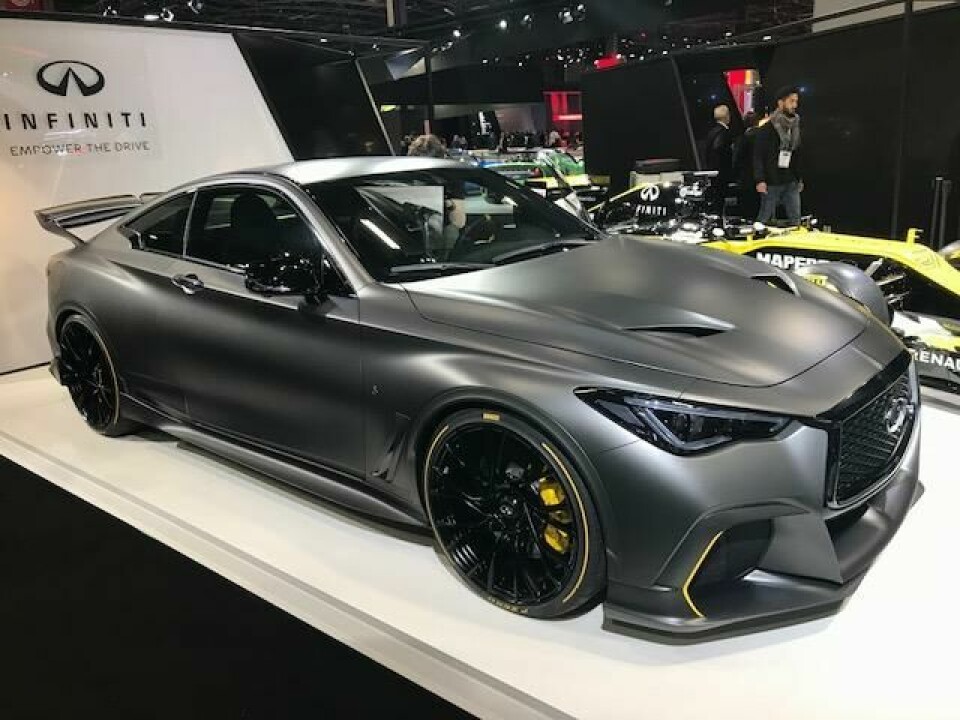
Paris 2018: Infiniti Project Black S
F1 tech and lots of carbon fibre in a suave Infiniti? Design director Karim Habib explains
Infiniti is exhibiting at Paris, in a small way, with the Q60-based Project Black S. Developed with the partners at Renault Sport F1, the Project Black S has all the visual signals you would associate with an F1-inspired sports car: carbon fibre trim, bespoke Pirelli tyres, a bright yellow accent and trim colour, and a large fixed carbon-fibre rear wing, but, as design director Karim Habib told CDN, a lot of the performance elements of the car are in its energy-harnessing technology.
“The question was ‘what would something Infiniti look like if you cooperated with the Renault Formula 1 team?’ We are technical partners, not just stickers on the side of the car, and we want the brand to benefit from that,” says Infiniti’s relatively new head of design. Last year the concept car based on that idea for Project S Black was shown and, this year, Paris has the fully engineered version. “So this is a full runner,” said Habib. “All of the design themes that were there last year have been aerodynamically tested and thermally tested plus fine-tuning engine cooling and, of course, downforce. This is a running prototype.” The motoring media will be able to drive this car at the end of 2018, he told CDN.

“It is our attempt at showing the best performance car we can build and one thing that is quite important, an important part of the typology, is the KERS [energy recovery system]. Energy is regenerated, from braking, power is gathered, but also, one of the most interesting things about this, which is directly from Formula 1, is that the heat from the exhaust is being regenerated into battery power,” said Habib. “That we can use for added performance… it is complex, expensive technology but it is a direct link to Formula 1 and If we come to this part of the market we need to do it in a way that is not like any of the other brands, whether it is M or AMG. But most importantly as we have decided that we are going to be fully electrified, we should do something that is electrified. If we did something now that was just a bigger engine I don’t think that it would make a lot of sense,” he said.

Infiniti has recently announced that all its vehicles will be electric so, we asked, how can you communicate performance on electric cars? “I think you still need to [communicate performance) in the premium segment… I just think we need to express it in different ways,” answered Karim. “On internal combustion engines they have bigger grilles and bigger intakes on the front because they need more air, but when you go electric that quest for cooling is somewhere else, so you have to find different visual codes to express that.

“It is maybe an easier exercise when we talk about the Prototype 10 because that is a low, wide sports car and already has the bones for sportiness and performance, but otherwise I think there is an opportunity to do something sporty but more restrained, more composed, cleaner, maybe, and that is an opportunity for us at Infiniti because of the way we want to interpret Japanese design.

“That is a big part of why we are doing new cars – not only new technology but also because we want to be more confident about the Japanese roots of the brand, and we think it can be a differentiator. We are trying to find that clearly Japanese identity without falling into the clichés of using tatami floors or things like that. What I am discovering, having been there [in Japan] for a year is that sometimes magical combination of restraint and minimalism, but also warmth and humanity.”




